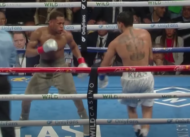UFC Decision Rulings Have Risen Since 2007, Nearly One in Two Bouts Are Decided by Judges
While many fans and pundits may still be debating the events which prompted the cancellation of UFC 151, rest assured, it won’t be long before another controversial decision ruling takes over the coveted ‘water cooler’ spot.
Of course, prior to Jon Jones turning down a short notice bout with Chael Sonnen, many observers were still discussing the split decision ruling at UFC 150, which handed Benson Henderson his second decision win over Frankie Edgar. The first, a unanimous decision victory in February, was also widely discussed and debated.
Judging by the MMA headlines over the last few years, there has been no shortage of decision rulings that have prompted outrage and debate. The narrative that usually accompanies these ‘outrageous’ bouts points at misinformed judging as the culprit. If the fight took place in a state or region where pro MMA is somewhat new, then the public fleecing of the officials is typically threefold.
While there’s no question that the Octagon has been home to far too many mind boggling decisions, could these rulings be standing out even more so, because judge’s are being called on more often? In other words, has the saying “don’t let leave it in the hands of the judges” become so tiresome, simply because more fights are going to decision than say five years ago?
Well, according to some number crunching that could be part of it. After breaking down all of the outcomes to take place in a UFC fight since 2007, bouts are more likely to be determined by the judge’s scorecards today than five or six years ago.
For example, according to the Full Contact Fighter database, in 2007, 61 of the 162 bouts in the UFC went to decision. That means 37.6% of the fights that year did not end by stoppage or submission. In 2008, the number of fights going to the scorecards was even less, as only 64 of 201 bouts resulted in decision for a 31.8% score.
After a 2009 campaign where 37.7% of the bouts were decided by the judges, decisions rose by approximately ten points in 2010 to 48.1%. In 2011, the amount of decisions remained constant at 48.6 %, while to date in 2012, 45.6 % of UFC fights are going to the scorecards.
While for some people, these figures may not reflect a dramatic rise in decisions, it does indicate that nearly one in two bouts are going the distance. This conclusion feeds a whole other narrative regarding the reasons why this could be, and whether game planning strategies to win fights, rather than finish them, is a factor.
The evolution of the UFC competitors themselves is also something to consider. The fighters of today are much more well rounded and capable of fighting in various ranges than the sport’s pioneers. Perhaps, as a result, today’s fighters are more adept at avoiding fight ending techniques.
The data also indicates that the amount of split decision rulings has fluctuated over the last six years. In 2007, just 4.9% of UFC bouts were declared a split decision, and that number continued to rise until 2009, when it hit 11.6%. In 2010, however, the amount of split decision rulings dropped to 9.3 % and so far this year, 8.6 % of bouts in the Octagon were seen differently by one of the three judges. If there had been a dramatic rise in split decisions, then that would further bolster the argument that the scoring criteria is not being consistently implemented.










